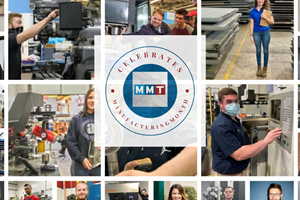Detailed Training Plan
Finding, Training & Retaining Employees, Part 3
When it comes to the skilled trades, the words “training” and “retaining” are undoubtedly connected. When a company invests in training for their employees, retention is always higher. Yet the definition of training can be confusing. In this industry, people are going to learn no matter what. Whether they are learning to be a moldmaker, a CNC machinist or a designer–they are going to learn by simply being part of the trade. Though there is a lot of learning taking place, oftentimes a structured path of training is missing, leaving the worker confused and sometimes disgruntled wondering if they have a future.
Learning and training are not the same thing. We can learn a lot about a topic, but that does not mean we are well trained. By definition training is structured; it has a start point and an end point. Training is measurable. Though learning should never end, we should know when training is complete. We should know when we are being trained and when we are not. Most people can tell the difference—this is why training is connected with retention. Employees can tell the difference between a company that expects them to “learn as they go” and one that has taken the time to make sure they are being trained properly. Employees can recognize whether or not they are being presented a path of development or a path to nowhere.
This is one of the single biggest ways that companies lose their employees. They fail to present a clear career path for their employees. They allow their most valuable asset to be developed through tribal-knowledge alone. Many of our newest workers in the industry are lost because of it. To retain your next generation of talented workers, you must offer a clear path of development that is hinged on structured and measureable training.
This means you must define each job description and map out the path to get to the next logical job (or jobs) up the ladder. The map should include a detailed list of the necessary competencies needed to progress. For example: if a person starts in your shop sweeping floors, where would they go after that? And what would they need to know to get there? It seems a logical next step from sweeping floors might be to do CNC machine set-ups. What do they need to know before they can do it? They need to know at least the following (and a lot more): how to indicate a part straight; proper workholding; how to identify the axes of a machine, etc.
When a person starts sweeping the floors, they should be told that they need to know the above items before they will get an opportunity to advance to machine set-ups. They should be presented with their options for how the company will help them learn those items and how they will be measured. When we develop people before they actually need the skill, they know they are being trained and they will be able to more easily see the path ahead of them.
By being able to see the path in front of them through a robust training plan, employee retention will increase dramatically. Each job description in your company should have a detailed training plan in place. This will help your employees see their future in the trade. Our skilled tradesmen and women are, and will continue to be who define us as an industry. We must invest as much effort and planning into how we will handle them as we do in creating a plastic mold.
Related Content
Hands-on Workshop Teaches Mold Maintenance Process
Intensive workshop teaches the process of mold maintenance to help put an end to the firefighting culture of many toolrooms.
Read More2021 30 Under 30 Honors Program: Mentoring in the Next-Generation of Moldmaking Professionals
Young professionals are vital to the moldmaking industry, and it is important to acknowledge those making strides in shaping the industry's future. MoldMaking Technology recognizes the industry's young talent through its 30 Under 30 Honors Program.
Read MoreMMT Chats: Marketing’s Impact on Mold Manufacturing
Kelly Kasner, Director of Sales and Marketing for Michiana Global Mold (MGM) talks about the benefits her marketing and advertising, MGM’s China partnership and the next-generation skills gap. This episode is brought to you by ISCAR with New Ideas for Machining Intelligently.
Read MoreTackling a Mold Designer Shortage
Survey findings reveal a shortage of skilled mold designers and engineers in the moldmaking community, calling for intervention through educational programs and exploration of training alternatives while seeking input from those who have addressed the issue successfully.
Read MoreRead Next
Finding, Training & Retaining Employees
In this multi-part series of articles, contributor Ryan Pohl, a journeyman CNC machinist who also holds a master's degree in industrial training and development, addresses the skilled-labor shortage and its potential to dramatically hinder the future sustainability and growth of the moldmaking industry.
Read More




















